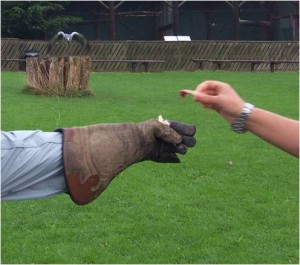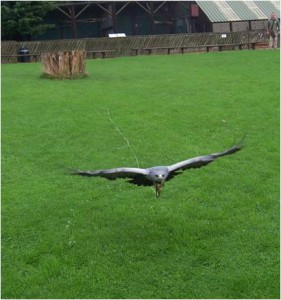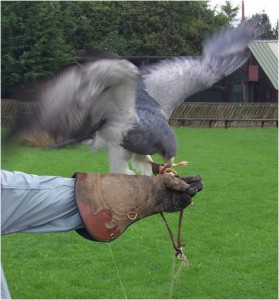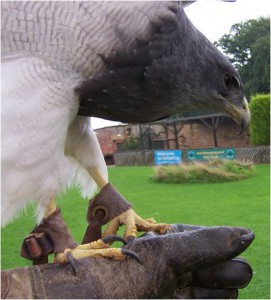In my post “Falconry in the Romantic Age”, I described that falconry was still practiced in the Regency period by gentlemen and ladies alike. Just as scriptwriter Andrew Davies, who used falconry in the movie adaptation of “Sense and Sensibility” to characterize Colonel Brandon, you might want to include falconry in your novel. You could create a thrilling hunting scene or have your heroine impress your hero with her falconry skills.
In the Romantic Age, Falconry was called hawking. To get an idea of how a character of a Regency novel would experience hawking, I took a discovery course in this noble sport myself when I went to England last year. I had pre-booked a half-day experience at The Birds of Prey & Conservation Centre at Sion Hill Hall, near Thirsk, Yorkshire. There are of course many other falconry centers in the UK, and also some country hotels that have similar offers.
A Falconry Experience
You are most likely to start with an introduction to the falconry equipment. I have collected some vocabulary for you here.
Block – a perch for the larger birds of prey, with a soft top and a spike at the bottom which is driven into the ground to secure it. Short-winged and broad-winged hawks are tethered to a bow perch or round perch.
Jesses – strips of strong leather on both legs of the bird.
Creance– a long light line which is tied to the jesses. It is used only when training the bird to fly between a perch and the fist.
Fist – the falconer’s gloved and protected hand.
Gauntlet or glove – leather glove to protect the hand and to turn the arm into a suitable perching surface.
Imprinting – a term used for describing what happens when very young birds are raised in the company of humans and come to accept humans as their parents and as source of food.
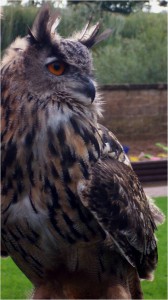 After the theory you will meet your first bird of prey. For beginners, this often is an owl, as they are less fierce looking and therefore less intimidating than a hawk. An exercise might teach you to gently take the bird off its block and to put it back to it. If you are allowed to, don’t miss to feel the fluffy feathers of the owl.
After the theory you will meet your first bird of prey. For beginners, this often is an owl, as they are less fierce looking and therefore less intimidating than a hawk. An exercise might teach you to gently take the bird off its block and to put it back to it. If you are allowed to, don’t miss to feel the fluffy feathers of the owl.
Having mastered the introduction, you will probably have a chance to “fly” the birds. “Flying” means the bird will fly from a wooden block (or others) on your fist. Of Course, the bird’s trainer is still in control of the exercise, so there is nothing to worry about. To make a bird of prey fly to your fist, the trainer will put a piece of fowl, probably a leg, on your glove. Birds of prey are, after all, carnivores (just mentioning, in case you are a dedicated vegetarian or feel a bit queasy about having parts of dead birds placed on your gloved fist: hawking might not be the thing for you.)
The photos show how the bird flies onto a fist:
And this is how it looks from your perspective when the bird sits on your fist:
I had the chance to work with different birds of prey, and each of them had its own distinctive character: Willie, a Grey Eagle Buzzard, was sharp, fast and eagerly went for his food; Stella, a Red Tailed Hawk, was gentle and slightly dreamy; and Cornelius, a Great Horned Owl, was grumpy in a cute way.
The highlight of the falconry experience was a hawk walk in the surroundings, of course still together with the trainer. As the birds were not trained to hunt actively, we had them fly to and from our gloves, and they were again rewarded with chicken legs.
While a day of falconry doesn’t turn you into an expert, it gives you a good idea how it would feel for your heroine or hero to hunt with birds of prey. Also, scenes for a novel may arise from your personal falconry experience. Feel free to share your ideas, inspirations and experiences by using the comment field below.
Find more Adventures for Regency Enthusiasts here:
Sources:
http://www.flyingfalcons.co.uk/traditions.html
http://en.wikipedia.org/wiki/Falconry_training_and_technique

